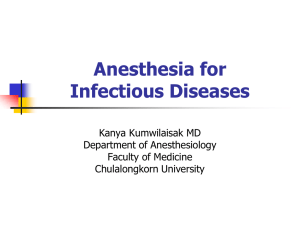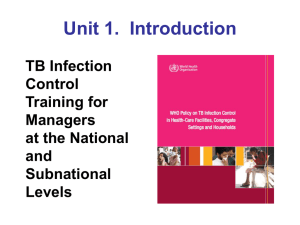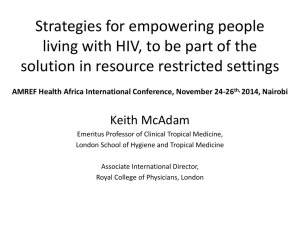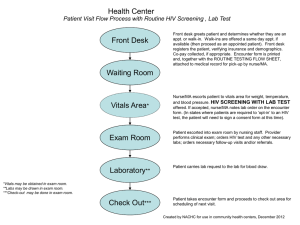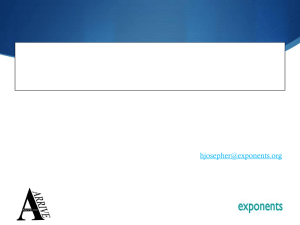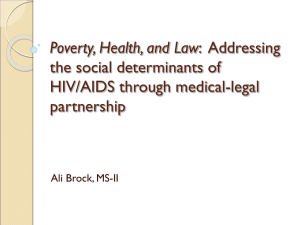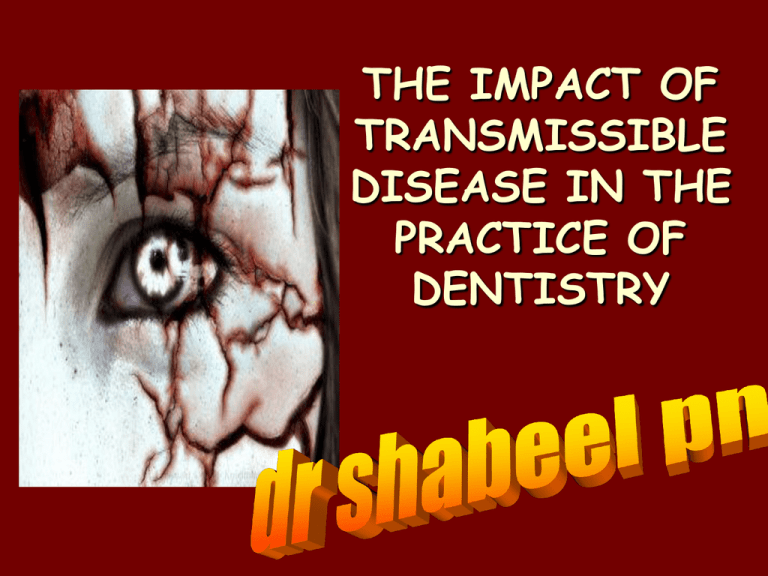
THE IMPACT OF
TRANSMISSIBLE
DISEASE IN THE
PRACTICE OF
DENTISTRY
INTRODUCTION
Many diseases are encountered in dental
practice.
The most common infectious disease we
may encounter or give importance to in
dental practice are bloodborne diseases or
diseases that need transfer of body fluids
such as blood or serum from the infected
to the recipient.
INFECTIOUS DISEASES
COMMONLY ENCOUNTERED IN
DENTISTRY
CONDITION
HABITAT
ROUTES OF
TRANSMISSION
Oral, pharynx,
ano-genital,
skin, viscera,
eye.
Contact lesion
exudate, saliva,
sexual contact,
blood.
SEXUALLY
TRANSMITTED
DISEASES
1.Herpetic
infections
2.Acute
Oral, gingiva,
herpetic
pharynx.
gingivostomatiti
s
Fingers, hands.
3.Herpetic
Whitlow
4.Gonococcal
infections
Oral, pharynx,
genitals.
Contact lesion
exudate, blood,
saliva.
Contact lesion
exudate, blood,
saliva.
Contact lesion
exudate, blood,
saliva,
nasopharyngeal
secretions.
5.Chlamydial
infections
Genitals, eyes,
oropharynx
Contact lesion
exudate, genital
secretions,
secretions from
eye.
6.Trichomonal
infections
Contact lesion,
Genitals, oral,
mucosa, saliva,
oropharynx,
blood, body
gastrointestinal fluids.
7.Condyloma
Acuminatum
Ano-genital
Contact lesion,
skin, oral,
mucosa, blood.
mucosal areas.
8.Syphilis
9.Infectious
Mononucleosis
10.Hepatitis B
virus Infection
Genitals, skin,
oral mucosa,
oro pharynx.
Contact-lesion,
mucosa,
saliva,blood,
body fluids.
ContactSkin, oral
mucosa, saliva,
mucosa,
lesion exudate.
genitals,
parotids, saliva.
Liver,
blood,body
fluids.
Contactblood,saliva,bo
dy fluids.
11.Hepatitis D
virus Infection
Liver, blood.
Contact-blood,
saliva, body
fluids.
12.Hepatitis C
virus Infection
Liver blood.
Contact-blood,
saliva, body
fluids.
13.Human
Blood, oral
Immunodeficien mucosa, skin.
cy Virus
Infection
Contact-blood,
semen, nonintact skin,
Respiratory
Diseases
1.Common cold Upper
Respiratory
Tract.
2.Sinusitis
3.Pharyngitis
Aerosol,
Contact.
Upper
Respiratory
Tract.
Aerosol,
droplet.
Upper
Respiratory
Tract
Aerosol,
droplet.
4.Pneumonia
Respiratory
Tract.
Aerosol,
droplet.
5.Tuberculosis
Respiratory
Tract.
Aerosol,
droplet.
6.SARS
Respiratory
Tract.
Aerosol,
droplet.
7.Avian
Respiratory
Influenza(H5N1
Tract, GIT
Flu)
Aerosol,
droplet.
Childhood
Diseases
1.Chicken pox
Oral, skin.
Droplet, contact
2.Herpangia
Oral,
Oropharynx.
Droplet, contact
3.Hand, foot &
mouth disease
Oral, hands,
feet.
Droplet, contact
4.Rubella &
Rubeola
Respiratory
tract, oral skin.
Droplet, contact
5.Mumps
Parotids,
pancreas,
testis, CNS.
Droplet, contact
6.Cytomegalo
Virus Infection
Droplet, contact
Salivary glands
Other
Common
Conditions
1.Hepatitis A
virus
Infection
Liver,
Ingestion, rarely
gastrointestinal blood.
tract.
2. Hepatitis E
virus Infection
Liver,
Ingestion, rarely
gastrointestinal blood.
tract.
ORAL LESIONS ASSOCIATED WITH INFECTIOUS
DISEASE
HEPATITIS
Viral hepatitis refers to a primary infection of the liver.
Caused by any of the heterogenous group of ‘hepatitis
viruses’ which currently consists of types A, B, C, D, E
and G.
All the hepatitis viruses are RNA virus.
Except type B which is DNA virus.
HBV and HCV commonly causes occupational spread of
infection.
Hepatitis mainly transmitted through
Fecal-Oral route
Transfer of body fluids either parenterally/sexual
contact.
Diagnosis
-detection for Ag*IEM
*ELISA
*Isolation
-detection for Ab*IgM indicates recent infection
* IgG -recent/remote infection and immunity.
Treatment
– General Preventive Measures
Health education
Improvement of personal hygiene
Strict attention to sterility
– Immunisation
Passive Immunisation
Active Immunisation
– Plasma Derived Vaccine
– Recombinant yeast hepatitis B
HEPATITIS VIRUS
HEPATITIS C LESION
COMPARISON OF HEPATITIS
VIRUSES
TYPE
A
B
C
D
(super
/piggyback
virus)
E
G
TTV
(recently
identified
virus)
SOURCE Feces
Blood
and
body
fluids
Blood
and
body
fluids
Blood Feces Blood
and
body
fluids
Blood
possib
ility
feces
PRIMARY FecelMODES
oral
OF
TRANSMI
SSION
Percuta
neous;
permuc
osal;se
xual
Percuta
neous;
permuc
osal
Percuta Percuta Fecelneous; neous oral
permuc
osal
Blood
INCUB
ATION
PERIO
D.
RISK
OF
CHRON
IC
INFECT
ION
15-50
days.
No
chronic
infectio
n
50-60
days.
Varies
with
age:
Adults
5-10%;
Children
2550%;
Infants
>85%
15-150
days.
Very
high
15-150
days.
5%
when
acquire
d as coinfectio
n with
HBV;
>70%
when
acquire
d as a
2nd
infectio
n in
chronic
HBV
carrier
15-60
days.
No
chronic
infectio
n
Unknow Unknow
n.
n.
Unknow Unclear
n
whether
chronic
infectio
n occurs
Protec
tive
immun
ity
after
infecti
on?
Yes;
AntiHAV Ab
Usually;
Ab to
core Ag,
and
surface
Ag are
produce
d;
Ab
(HbsAg)
are
produce
d;
Ab
HbsAg is
most
protecti
ve;
chronic
carrier
states
exists.
No;
antiHCV Ab
is
produce
d but is
usuallay
not
protecti
ve.
Because Unknow
HDV
n
infection
requires
previous
infection
or coinfection
with
HBV,
protecti
ve
immunit
y is
similar
to
hepatitis
B
Unknow
n
Unknow
n
VACCI
NE
AVAIL
ABLE?
Yes
Yes
No
Yes
No
No
No
(HBV
vaccine
protect
s
against
HDV)
• India with a population of approximately 1 billion stills
harbors approximately 30 million HBV carriers.
• HBV is responsible for about 68% of cirrhosis of liver
and 80% of hepatocellular carcinoma in India.
HUMAN IMMUNODEFICIENCY
VIRUS
NOT single factor has affected the practice of
dentistry since the early 1980’s more than
acquired immunodeficiency syndrome.
HIV is a condition where transmission occurs
through contact with blood and other body
fluids.
This disease was identified in June 1981 and has been
the plague of the 20th century.
Initially seen among
homosexuals
later in all parts of society- heterosexuals, females and
children.
The initial HIV infection progresses into a more
severe and debilitating condition where it is
associated with a variety of other infections and
is called Acquired Immuno Deficiency Syndrome
(AIDS)
In the EARLY stages- infection
- may not be noticeable and may be
accompanied by symptoms such as weakness,
arthralgias or
- even totally asymptomatic.
On progression- infection
- may be associated with a variety of
conditions.
HAIRY
LEUKOPLAKIA
ORAL CANDIDIASIS
Some of the ORAL LESIONS associated with HIV
infection and AIDS – Hairy Leukoplakia, Kaposi’s,
Sarcoma, Candidiasis, etc.
Systemic conditions associated with AIDSprotozoal, fungal, other viral and myobacterial
infection.
Diagnosis
– Detection of Ag
Test for p24 core Ag- represent acute/sero conversion
– Detection of Ab
Screening test- ELISA
Confirmatory test- Western blotting
KAPOSIS SARCOMA
EXTENSIVE KAPOSIS
SARCOMA
Treatment
– General Management
– Treatment and prophylaxis of oppurtunistic infections
and tumours
– Immunorestorative Measures
– Antiviral therapy
India is among the highest caseload of HIV
infected people with about half the population in
sexually active stage .i.e.15 years and
above(0.3%).
Population of India is 1 billion and the
population with HIV is 2.4 million.
First HIV case was detected in 1986 by Dr S.
Solomon.
The spread of HIV in India has been diverse
with much of India having a low rate of
infection and the epidemic being more prevalent
in the southern region and the far north-east.
Highest HIV prevalence rate in India
– Far north-east i.e. Manipur, Nagaland- due to unsafe
injection drug use, sex workers.
– Southern states i.e. Tamil Nadu, Andhra Pradesh,
Karnataka- due to sexual contact
– West i.e. Maharashtra, Gujarat
In 2000 Larry Kramer, the co-founder of the
AIDS Coalition to Unleash Power, reminded the
world that AIDS crisis is more devastating than
ever.
“Even if we were to find a cure tomorrow,
millions and millions of people will die. You were
all told this before it was too late. Now it is too
late. So sit back and watch the destruction of
world.”
Dealing with the HIV and its consequences may
prove to be the greatest challenge ever faced by
the dental profession.
The manner in which dentistry responds to this
challenge may, to a large degree, shape
dentistry’s FUTURE.
TUBERCULOSIS
Tuberculosis is one of the oldest infectious
diseases known to humans.
Causative organism- M.tuberculosis
Transmission by inhalation of infective droplets
expelled through cough by an infectious patient
with active pulmonary disease.
Mostly affects lungs
But can virtually affect every organ system in
the body.
TB is able to produce acute to latent chronic
disease
TUBERCULOUS LUNGS
ORAL TUBERCULOUS
LESION
Diagnosis
–
–
–
–
–
–
–
–
Sputum AFB
Gastric lavage
BAL
Trans Bronchial Biopsy
PCR
Culture
ESR
Mantoux test
–
–
–
–
Rifampicin
INH
Ethambutol
Pyrazinamide
Treatment
Tuberculosis has been and
continues to be taking a
terrible toll on the Indian
population.
Causes 3,64,000 deaths
annually.
There were more than
1.8 million new TB cases
in India in 2004.
It represents 1/5th of all
TB cases worldwide.
ORAL TUBERCULOUS
LESION
RISK TO THE PATIENT
• Health care workers; primarily physicians and dentists,
have a 3 fold to 5 fold higher prevalence of HBV than the
general population does.
• HBV transmission had been well documented from
dentists to patients.
• Since the early 1970’s when serologic testing became
available for HBV, the CDC had reported on 20 clusters
of HBV transmission to more than 300 patient from
infected health care workers.
• In 12 of the clusters the health care worker did not
routinely use gloves, and some reported skin lesions that
could have promoted the transmission.
• Nine of these clusters were linked to dentists or oral
surgeons.
• Most of the reports were before the acceptance of
Universal Precautions.
• The CDC suggested that “the limited no .of reports of
HBV transmission from HCWs to patients in recent years
may reflect the adoption of Universal Precautions and
increased use of HBV vaccine.
• Recent reports of HBV transmission from a health care
worker to patients during performance of invasive,
exposure-prone procedures are not among dentists, but
refer to a surgeon who is HBeAg +ve and had not been
vaccinated against HBV.
• Factors of transmission were more likely related to
irritations on the surgeon’s fingers and virus which may
have escaped through tiny holes in the gloves was found
in the glove washings.
• However transmission from HIV infected dental health
care workers to patients had not yet been reported.
• HERPES transmission occur mostly from from dental
hygienists to patients.
• HCV transmission in health care facilities has also been
documented.
• Simultaneous transmission of HIV and HCV to a health
care worker who sustained a deep needlestick injury
from an HIV/HCV infected source patient in 1990 was
reported.
• Use of zidovudine was declined.
• Researchers at the International Conference on
Emerging Diseases convened in 2000 reported that
Health Care Workers had a 20 to 40 times greater risk of
contracting HCV from an accidental needlestick than
HIV.
RISK TO DENTAL HEALTH CARE
WORKERS
• The first case of occupationally aquired HIV
infection, by needlestick, was reported in Africa
in 1984.
• As of December 31, 1999, 56 health care
workers had been reported to CDC as having a
documented occupational transmission of HIV.
• Among the documented cases
–
–
–
–
48 reported percutaneous exposure.
5 blood splashes to eyes, nose or mouth.
2 percutaneous + mucocutaneous exposure
1 reported an unknown route.
• Reporting occupational incidents to agencies is
important in tracking not just seroconversion but
the routes and circumstances of injury as well.
• CDC has 2 programs for voluntary reporting:
– Incidents related to Known HIV infected
source individuals reported to – The National
Studies for Infectious Disease.
– Documented HIV seroconversion reported to
– local/state health department, which further
reports to CDC.
– Reports of medical device failures that may
facilitate the injury should go to the FDA
Medwatch program.
• In February 1995, OSHA issued a guide to dental
employer obligations as a follow-up to the bloodborne
pathogens std in regard to occupational exposure.
• The employer is obligated to provide, not perform, a
confidential medical evaluation and follow-up by a
licensed health care professional at no cost to the
employee.
• The medical services that the employee must be offered
are counseling, collection and testing of the employees
blood, post exposure prophylaxis and evaluation of
reported illness.
• The employer is obligated to pay the cost of treating the
incident and not the cost of the subsequent disease
should seroconversion occur.
• The current U.S. Public Health Service recommendation
is that health care workers who are exposed to HIV on
the job should, in many cases, take zidovudine and other
antiretroviral drugs after exposure to reduce their risk of
becoming infected.
• Most percutaneous injuries occurred outside the
patient’s mouth, most on the hands of the
dentist. Burs were the most common
source(37%), followed by syringe needles(30%),
sharp instruments(21%) and orthodontic
wires(6%).
• The best estimates of risk to health care
workers:
– 0.3% for HIV transmission from percutaneous
exposures and 0.09% for mucous membrane
exposures
– 3-10% for HCV
– 30% for HBV transmission from after percutaneous
injury from an infected patient.
PREVENTION & INFECTION
CONTROL
Even if cure is available, protection from
the untoward effects and discomforts of
each disease would be desirable.
Because many diseases can go
undetected for long periods of time, the
focus must be on preventing disease
transmission from providers to patients,
vice versa and between patient and family.
Methods for the prevention and
infection control includes:
Medical history
Vaccinations
Protective Attire and
Barrier Techniques
Handwashing and Care of
Hands
Use and Care of Sharp
Instruments and Needles
Disinfection in the
Dental Laboratory
Use and Care of
Handpieces,
Antiretraction Valves,
and Other Intraoral
Dental Devices
Attached to Air and
Water Lines of Dental
Units
Single-Use Disposable
Instruments
Sterilization and Disinfection of
Instruments
Cleaning and Disinfection of Dental unit
and Environmental Surfaces
Use of Extracted Teeth in Dental Education
Settings
Disposal of Waste Materials
Boil Water Advisories
Dental Unit Water Quality
Infection Control in Public Health Settings
WHEN CAN INFECTED
CLINICIAN RETURN TO WORK?
CONDITION
WHEN SHOULD ONE RETURN TO
WORK/WHAT IS TO BE DONE?
Conjunctivitis
Staph. Aureus
Strep. Group A
After discharge ceases.
After lesions have healed.
24 hrs after starting effective
antimicrobial treatment.
After resolution of acute infection.
Viral Respiratory
Infection
Active tuberculosis After treatment with antimicrobials.
Positive skin test for
TB
After evaluation of infectious status,
chest X ray, and treatment if needed
till deemed non-infectious.
After symptoms resolves.
Influenza
Pediculous (hair lice) After treatment provided and no lice.
After lesions heal.
Herpetic Whitlow
After lesions heal, need to be
Orofacial Herpes
regularly on anti-herpes medicines
for the rest of the life.
After lesions dry and crust out .
Chicken pox
After lesions dry and crust out.
Shingles
HCV seropositive Need to use UP/SP, Proper Aseptic
HIV/AIDS
Measles
Mumps
Rubella
Pertussis
Techniques to protect patients, Anti-viral
Medication,Monitoring.
After anti-retroviral therapy started,
US/SP and expert panel/ Infectious
Diseases MD to monitor clinician.
After 7 days from the appearance of
rash.
After 9 days from start of parotitis.
After 5 days from the appearance of
rash.
After 5 days from the start of effective
antimicrobial therapy.
HBV
After deemed HBe antigen –ve,
UP/SP and expert panel /Infectious
diseases MD to monitor clinicial.
After symptoms resolve.
Diarrhea
After starting effective antimicrobial
Amoebiasis
therapy and symptoms resolve.
After symptom resolves.
Enteroviral Infections
After 7 days from the onset of
HAV
jaundice.
LEGISLATION AND
LITIGATION
Refusals to treat
people with HIV/AIDS
by dentists and other
health care
professionals may well
be the most common
and blatant form of
discrimination against
people with HIV today.
TITLE III OF THE AMERICANS
WITH THE DISABILITIES ACT
Is specific in the type of
discriminatory conduct that is
prohibitted.
According to this it is illegal to do
the following:
1. Deny an HIV +ve patient the
“full and equal enjoyment ”of
dental services or Deny an HIV
+ve patient the “oppurtunity
to benefit” from dental
services in the same manner
as other patients.
2. Establish for the privilege
of receiving dental
services ”eligibility
criteria” that tend to
screen out patients who
have tested +ve for HIV.
3. Provide “different or
separate” services to
patients who are HIV +ve
or fail to provide services
to patients in the most
“integrated setting”.
4.Deny equal services to a person who is
known to have a “relationship“ or
“association” with a person with HIV,
such as a spouse, partner, child, or
friend.
Although the AWDA has specific prohibitions against
discrimination by places of public accommodation, it does
permit the denial of services to an individual where there is a
“direct threat to the health and safety of others”.
DECISIONS
Implementation of a policy
that the dentist would not
discriminate on the basis of
HIV/AIDS. Paying the estate
of the complaint $20,000 in
compensatory damages +
$9,000 in civil penalitiesUnder Title III of the AWDA
the Department of Justice (In
East Hartford).
Agreement including staff training on non
discrimination and requirements to provide
“equal services” to persons with HIV and “send
periodic reports to DOJ for the monitoring of
compliance” & Payment of $80,000 for
compensatory damage for refusal to treat an
HIV +ve patient- Federal Govt. (In Houston)
In addition (Owner and Managing companies of
Castle Dentals) paid $10,000.
Ruling of PRETEXT against the referal and
compensatory payment of $25,000+$ 25,000 for
punitive damage+ maintenance of policy of
nondiscrimination for refusing treatment for an
HIV +ve patient and refering to specialized
clinic- Federal Court in New Jersy.
THE FUTURE
• During 1996 World Congress of the American
Dental Association, members who questioned
the efficacy of Universal Precautions were
soundly defeated by the scientific community
reaffirming the effectiveness of Universal
Precautions.
• Courts have decided that it is safe to provide
oral health services to persons with HIV/AIDS,
But appeals to these decisions will determine
the future role of the profession, the protection of
the HIV infected, and the safety of providing oral
health care services.
REFERENCES
Clinical Periodontology – CARRANZA’S
Clinical Periodontology – RATEITSCHAK
JHONG’S Community Dental Health – GLUCKS ,
MORGANSTEIN
Textbook of Microbiology – ANANTHANARAYANA
Textbook of Microbiology – BAVEJA
Indian Dentist Research and Review.
Internet
THANKYOU


